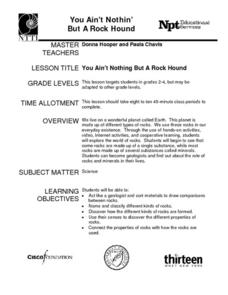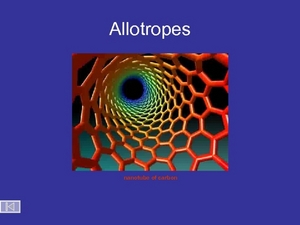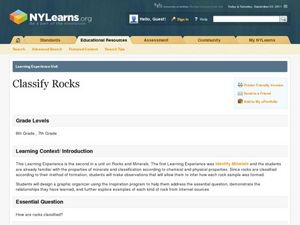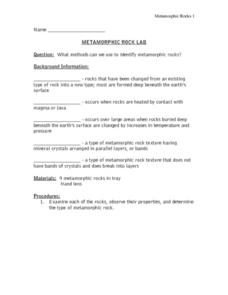Curated OER
Look Out, Below!
Students study the four layers of soil while identifying the substances that each level is composed up. They investigate the properties of soil such as color, texture, water retention and the ability to maintain life by growing a plant.
Curated OER
Detectives in the Landscape
Fourth graders explore landscapes. In this landscape lesson, 4th graders investigate different elements of landscapes. Students design a visual presentation using photographs taken during a nature walk.
Curated OER
You Ain't Nothin' But a Rock Hound
Here is an excellent lesson on rocks! In it, learners explore the world of rocks through the use of video, hands-on activities, and cooperative projects. This outstanding plan is chock full of terrific activities, websites, streamed...
Curated OER
Allotropes
Brilliant graphics depict a variety of allotropes, especially the allotropes of carbon. Some notes are available to help make these useful for teaching your young chemists, but not for every slide. With some additional preparation on...
NOAA
Ocean Zones
How can organisms light up in water? Bioluminescence is light produced in a chemical reaction that can occur in an organism's body. First, learners determine what happens to light/color as you move into the deep ocean. In groups, they...
Curated OER
A Healthy Diet is a Balancing Act
It's important to teach kids how to have a balanced diet. They are provided with six different meals, they fill in the blanks to complete each one to make it balanced. The answers could be anything and the meals offered don't seem very...
Curated OER
The Nature of Salt
Students record information from the periodic table for sodium and chloride. They determine whether salts are molecular or ionic compounds, along with sodium chloride's molecular weight, and relative weights
Curated OER
Our Earth
In this Earth's environment worksheet, students complete a crossword puzzle given 35 clues about a variety of topics related to our Earth. Topics include ecosystems, precipitation, biomes, energy transfer, soil, weathering and rocks.
Teach Engineering
Light Intensity Lab
Let there be light. The last installment of a seven-part series has pupils conduct an experiment on light attenuation through different numbers of transparency sheets. They then relate the results back to how X-rays measure bone density.
Curated OER
Classify Rocks
Students classify different types of rocks. In this earth science lesson plan, students test different rock samples and construct a chart to record observations. They create a concept map that answers essential questions.
Curated OER
Mystery Powders
Young scholars collect microscopic images from a variety of chemical specimens to determine the identity of a mystery powder. They use a ProScope Digital USB Microscope to describe and compare the crystal size and shape of the chemicals.
Curated OER
"Investigating Soil Color and Texture"
Ninth graders will identify/understand the differences between soil and dirt. They will classify soil color accurately and use Munsell notation to describe it (Munsell books provided).Students will classify soil texture using the feel...
Curated OER
Soil Stories
Tenth graders collect and analyze soil samples and extrapolate the characteristics needed to support different types of plant life. They research different types of prairie soil and how it supports plant and animal life.
Curated OER
Rainforest Plant or Animal?
Young scholars explore the major functions of plants and animals. In this rainforest lesson plan students create a Venn diagram to compare and contrast animals in the rainforest.
Curated OER
Our Earth Crossword Puzzle
In this earth's environment worksheet, students use the 20 clues and their problem solving skills to correctly complete the crossword puzzle.
Curated OER
What's Organic?
Students discuss background information presented by the teacher and read dictionary definitions for the words "organic" and "synthetic." In this gardengin lesson, students complete a worksheet on the material. Students grow and compare...
Curated OER
Diamonds Are Forever - Most of the Time!
Students examine the compositions and structure of diamonds. They conduct an experiment growing crystals, watch a video, and conduct Internet research.
Curated OER
Nature's Polyhedrons
Students discover the characteristics of polyhedra. Through hands-on activities and interactive videos, students investigate and retrieve information on polyhedra and crystal structures. Students study angles and symmetry. They...
Curated OER
Testing for Chemicals in Soils
Young scholars use sight, touch and chemical test kits to evaluate and classify soil types. They determine the organic content, soil pH, conduct visual analysis and nutrient tests of a variety of soil samples from various sources.
Curated OER
Metamorphic Rock Lab
For this metamorphic rock worksheet, students observe 9 metamorphic rock samples and indicate the grain size, if there are bands, if there are layers , if it is foliated and they identify the name of the rock. They complete 5 sentences...
Curated OER
Mystery Creek
Fourth graders are introduced to the Riparian Ecosystem. They define the following terms: riparian and riparian ecosystem. Students take a trip to the creek, where they make observations about the environment around them. They are...
Curated OER
Fieldwork: Horizons Under Ground: Digging Through Wetland Soil
Learners study the different soil types and describe the different soils in various environments. In this soil lesson students walk to a reserve and discuss what they saw.
Curated OER
Milk: A Practical Application
Explain the coagulation and coalescence processes associated with milk protein and cheese. List the components of milk and explain how each component is dispersed in the milk. Describe what happens when milk protein is coagulated Discuss...
Curated OER
Finding the Ages of Rocks and Fossils
High schoolers practice dating fossils. They learn the concept of "deep time"--that earth was formed billions of years ago. They experience excellent hand-outs and virtual age tutorial links.























